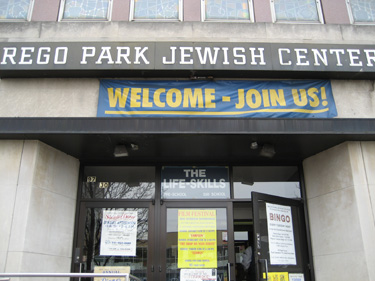Rego Park: Here v. There
From Decoding New York
| Introduction |
| Washington Heights |
| * Evolution |
| * Here v. There |
| * What's Real |
| * Economy |
| Rego Park |
| * Evolution |
| * Here v. There |
| * Economy |
| Comparison |
| * Photo Gallery |
| * Sources
|
Upon entering Rego Park it is clear from the grocery stores, pharmacies, and even clothing stores that the Russian influence on the prevalent Bukharian Jewish population has not waned even in the new country of America. Although, obviously Rego Park and the Russian-speaking mother countries of the residents differ, the immigrants clearly retain their identity through shops and businesses that can offer services in Russian and which can offer them a feeling of security among people who are just like them. It is estimated that about fifty thousand Bukharian Jews immigrated into America in the late twentieth century. Although this is not a large number, in a community like Rego Park this population is dominant. Obviously because these residents now live in America, their initial culture is diluted by customs and traditions of the "American" way of life, which ties into assimilation. It is of course difficult to estimate the extent of assimilation since it is a subjective topic, but it is important to point out that Bukharian Jewish immigrants have had to assimilate twice-once in America, and once in the Soviet Union. After all, Bukharian Jewish immigrants speak Russian, not Bukhori, which is because Russia "homogenized" the culture in the Soviet Union. For instance, Ukrainians don't speak Ukrainian, they speak Russian as a byproduct of the Soviet Union "cultural homogenization" (wanted people to let go of their own religions and languages). It is lucky if even the first generation of Bukharian Jewish immigrants understands Bukhori, as very few of them do. In fact, out of the one-hundred sixty thousand Bukharian Jews in the world, only 37.5% speak Bukhori.
Many Jewish immigrants, including Soviet Jews came over to the United States to get back their culture that the Soviet Union in many ways obliterated. For instance, one anecdote from observing the neighborhood is that there are no McDonald's or Burger King, which can normally be found in almost any neighborhood. But there was a Dunkin' Donuts, which can also be commonly found in many neighborhoods. This discrepancy can be attributed to the fact that the Jewish immigrants keep Kosher and would not appreciate a Burger King or McDonald's in their neighborhood (Meat vs. Dairy). This aspect demonstrates that this community assimilates selectively.
Rego Park fosters a sense of community. Through the Rego Park Jewish Center, men, women, and children are able to communicate with each other and express themselves. However, the Jewish Center is not the only place of cultural contact. According to a young Russian speaking man, “I love working out at the gym here. I stay fit and meet new people. Chinese, Koreans, Indians, the communication’s great and I learn interesting new things, what could be better?!”
On the other hand, when it comes down to seeking employment, many immigrants share their heart wrenching stories of having to start over, “We were doctors there, well respected people, and here, we are nobody” replied one elderly Bukharian woman. On the contrary, where the first generation is failing to obtain a career of their choice, the second generation is succeeding. “My son is a doctor, my daughter is a pharmacist and my second daughter is a lawyer. I love America. It is a very beautiful country,” commented an elderly Bukharian man. Assimilation patterns also differ among other populations that are found in Rego Park. For instance, an Indian couple who have two children demonstrated a certain hostility to the American way of life. When asked whether their children assimilated and became “Americanized,” the mother was quick in her reply, “Never! I raised my children right. They are Indian not American.” Not long afterwards, an Indian mother and her friend were encountered. They, on the contrary, proudly admitted that their children assimilated and are more or less “Americanized.” Clearly, views on assimilation greatly differ. Perhaps this battle against assimilation isn’t necessarily a battle against the American ideal; perhaps it’s a weapon in preserving one’s own culture. To a great extent, this battle of assimilation is what helps to form and maintain ethnic neighborhoods in New York.

